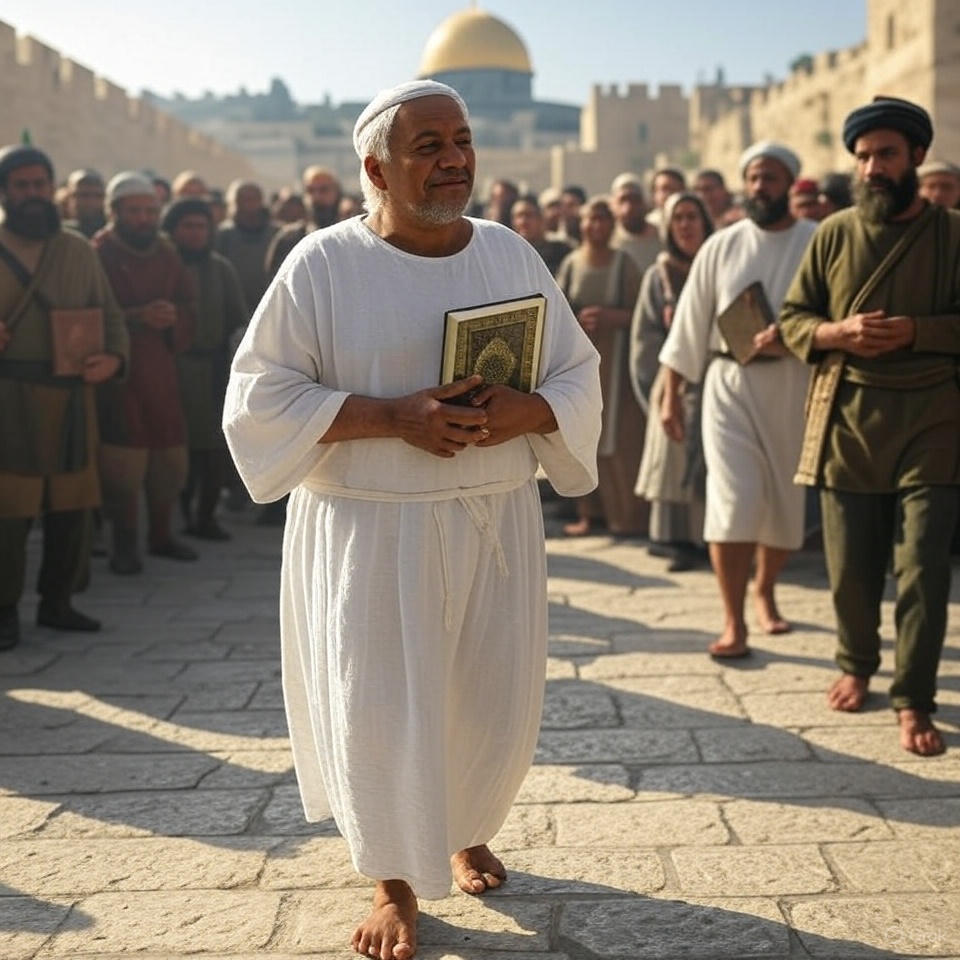Imagine a city perched on a hill, its golden domes and ancient stones whispering secrets of prophets and kings. The air is thick with the scent of olive groves and the distant clang of steel. It’s September 20, 1187, and the sun hangs low over the Judean hills as a vast army unfurls like a green banner across the landscape. This is no ordinary day—it’s the dawn of a siege that would shake the foundations of two worlds, Christian and Muslim alike. On this date, Saladin, the Kurdish sultan whose name still evokes images of chivalrous warfare, laid the first stones of encirclement around Jerusalem, the holiest city on earth. What followed was not just a clash of swords but a masterclass in human resilience, cunning diplomacy, and the rare grace of mercy in victory. Over the next twelve days, the walls of Jerusalem trembled under the weight of catapults and ambition, but it was the minds inside and outside those walls that truly decided the fate of empires.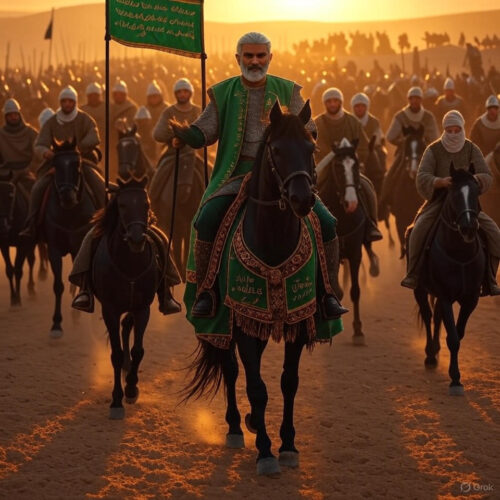
This story isn’t buried in dusty tomes—it’s alive, pulsing with the drama of real people facing impossible odds. We’ll dive deep into the grit and glory of that autumn in 1187, exploring the feuds, the fears, and the fierce determination that defined it. And because history isn’t just a rearview mirror, we’ll uncover how this event’s surprising outcome—a bloodless surrender forged in negotiation—can arm you today with tools for your own battles, whether in boardrooms, relationships, or personal crossroads. Buckle up; this is a tale of sieges both literal and metaphorical, where the greatest weapon wasn’t steel, but strategy.
#### The Fractured Kingdom: Setting the Stage for Catastrophe
To understand the siege, we must rewind to the tangled web of the Crusades, that epic saga of faith, greed, and glory that spanned two centuries. The First Crusade in 1099 had seen European knights, fueled by papal fervor and promises of salvation, storm Jerusalem in a frenzy of blood. Contemporary chronicler Raymond of Aguilers described the aftermath with chilling candor: “In this temple almost up to his knees in blood, our men waded there… Indeed, for that was the place where the heathen had slain the martyrs.” Piles of severed heads, rivers of gore—over 70,000 Muslims and Jews perished in what became the Kingdom of Jerusalem, a fragile Christian outpost in the heart of the Levant.
By the 1180s, that kingdom was a shadow of its former self. Internal squabbles among the nobility—think petty lords more interested in vineyards than vigilance—had eroded its strength. Baldwin IV, the leper king, ruled with tragic wisdom from 1174 to 1185, his body rotting while his mind plotted against the rising tide of Saladin. This Kurdish warrior, born Yusuf ibn Ayyub in 1137 near Tikrit (yes, the same town that would one day birth Saddam Hussein), had clawed his way from vizier to sultan. Under the banner of the Ayyubid dynasty, he unified fractious Muslim factions in Egypt and Syria, all while preaching jihad not as blind rage, but as disciplined reclamation.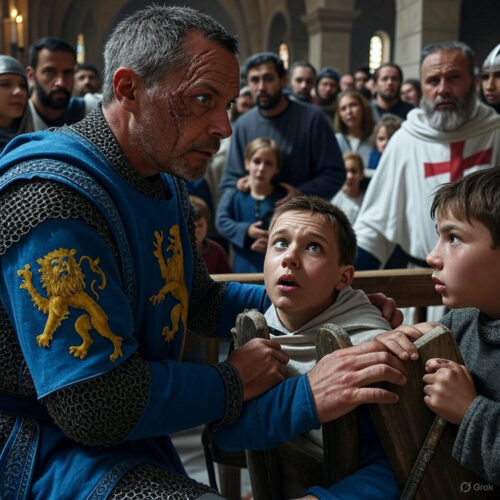
Saladin’s genius lay in his blend of piety and pragmatism. He fasted twice a week, memorized the Quran, and yet commanded armies with the precision of a chess master. By 1187, his forces—Turks, Arabs, Kurds, and Bedouins—numbered in the tens of thousands, a mosaic of loyalties bound by his charisma. The spark that ignited the powder keg? The Battle of Hattin on July 4, 1187, a sweltering inferno in the Galilee hills.
Picture it: King Guy of Lusignan, a hot-headed Frenchman thrust onto the throne by marriage to Queen Sibylla, marches 20,000 Crusaders to relieve the besieged fortress of Tiberias. Saladin, ever the tactician, lures them into a trap. His scouts torch the parched grasslands, denying water to the thirst-maddened Franks. As the sun beats down, Crusader knights in heavy mail clank forward, their horses foaming. Saladin’s emirs, like the fierce Gökböri, harry the flanks with hit-and-run archery. By dusk, the Christian army collapses in disarray. Guy is captured, along with the True Cross—a relic said to contain splinters from Christ’s execution. Thousands perish; survivors are marched to Damascus in chains. Chronicler Imad ad-Din, Saladin’s secretary, reveled in the irony: “The Franks were like moths in a flame, their pride consumed by the fire of our faith.”
Hattin’s aftermath was a domino fall. Saladin swept through the coast like a scythe: Acre surrendered on July 29 after a token resistance; Sidon fell on August 19, its garrison ransomed for 30,000 dinars. Beirut, that pearl of the Mediterranean, capitulated by late August, its markets stripped bare. Ascalon, the gateway to Egypt, held out until September 4, but even its vaunted walls crumbled under Saladin’s sappers—engineers who tunneled beneath foundations, propping them with wooden beams doused in pitch and set ablaze. The roar of collapsing stone echoed like thunder, a harbinger for Jerusalem.
Refugees flooded the Holy City. Balian of Ibelin, a battle-hardened baron from the noble House of Ibelin, arrived on September 7 with a small escort. Saladin, honoring a safe-conduct, allowed him passage to fetch his family. But whispers from Patriarch Eraclius and the desperate populace changed everything. “Stay, my lord,” they pleaded, “for the love of God and His Holy Sepulchre.” Balian, a man of honor forged in the forges of Outremer, knighted sixty burgesses in the Church of the Holy Sepulchre—elevating merchants and masons to warriors overnight. He dubbed children as young as fourteen, their boyish faces stern under ill-fitting helms. The city’s 60,000 souls—swollen by exiles—braced for the storm.
#### The Iron Ring Closes: Day One and the Fury of the Assault
September 20 dawned with a deceptive calm. From the minarets of the Al-Aqsa Mosque, watchmen spotted the dust clouds of Saladin’s host: 30,000 infantry, 12,000 cavalry, and a train of siege beasts—mangonels that hurled 200-pound stones, trebuchets crewed by Syrian artisans, and towers cloaked in wet hides to douse Greek fire. Saladin himself, clad in silk over chainmail, rode at the fore, his standard a green banner embroidered with Quranic verses fluttering like a prophet’s call.
The army encamped west of the city, before the formidable Tower of David—a bastion built by Herod the Great, its stones layered with Roman cunning and Crusader sweat. Reconnaissance parties probed the walls: the Jaffa Gate, a yawning maw flanked by double towers; the Damascus Gate, etched with scars from Saladin’s grandfather’s wars. Arrows whistled like vengeful spirits, testing the defenders’ nerve. Balian’s men—raw knights and grizzled Templars—replied with crossbows, their bolts singing through the air. One early volley felled a dozen Ayyubid scouts, their bodies left as grim warnings on the no-man’s-land.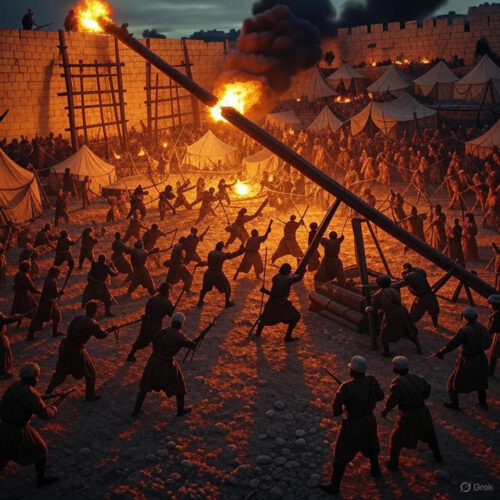
That first night, campfires dotted the hills like fallen stars. Saladin consulted his emirs in a tent aglow with oil lamps. “The Franks hold the city by God’s grace alone,” mused his nephew al-Afdal, “but their hearts are as brittle as their walls.” Saladin, ever cautious, ordered the ring tightened. By dawn of the 21st, sappers—bare-chested Kurds wielding picks and levers—dug at the moat’s edges, while oxen hauled the first mangonel into position. Nicknamed “The Furious,” it loosed its inaugural stone at midday, the boulder arcing like a vengeful comet to smash against the northern wall near the Golden Gate. Shards flew; a defender tumbled, his scream lost in the roar.
The rhythm of siege warfare set in: dawn volleys, midday assaults, twilight lulls for prayer and patching. Crusader sallies—desperate dashes from the gates—kept the besiegers off-balance. On the 22nd, a sortie from the Zion Gate caught a supply train unawares, seizing crates of dates and arrows before retreating under a hail of shafts. Balian led one such foray himself, his sword a blur, felling three Mamluks before a lance grazed his shoulder. Back inside, he rallied the weary: “We fight not for gold, but for the tomb where our Lord lay!”
Saladin adapted swiftly. His engineers, drawing on Byzantine manuals smuggled from Constantinople, erected counter-siege towers—wooden behemoths on wheels, shielded with iron plates. These “belfries,” as the Franks called them, creaked forward on the 23rd, their archers raining death from on high. Defenders countered with boiling oil and flaming pitch, hurled from cauldrons atop the ramparts. The air reeked of charred wood and seared flesh. One belfry ignited spectacularly, its timbers crackling as it toppled, crushing two dozen below in a pyre of splintered glory.
#### The Breaking Point: Miners, Mangonels, and Mounting Despair
By the 24th, fatigue gnawed at both sides. Saladin’s army, far from home, grumbled over meager rations—barley bread and brackish water from hauled cisterns. Desertions trickled; a Bedouin scout was caught selling intelligence to Balian’s spies for a pouch of silver. Inside the walls, famine loomed. The refugee swell had devoured stores; bread rose to a dinar a loaf, and cats fetched premium prices in the shadowed alleys. Women wove sandbags from tent scraps to shore up breaches, while children gathered spent arrows like grim harvest.
The 25th marked a pivot. Saladin, noting the sun’s glare blinded his archers on the western front, relocated to the Mount of Olives—a hill sacred to Christians as the site of Jesus’ ascension, now a vantage for Muslim vengeance. From here, away from major gates, his forces were safe from counterattacks. The new position overlooked the Kidron Valley, allowing enfilading fire on the eastern walls. “The sultan has eyes like eagles,” whispered a Frankish sergeant, as stones began pummeling the Golden Gate anew.
Miners entered the fray on the 26th. Teams of 50, lit by tallow lamps, burrowed under the wall near the Damascus Gate. Timber supports groaned under the earth’s weight; Franks above detected the tremors and counter-mined, their shovels clashing in subterranean duels. One tunnel collapsed, burying 20 sappers alive—their muffled cries haunting the besiegers. Above ground, the barrage intensified. Mangonels, twisted ropes of hair and sinew powering their throws, lobbed not just stones but incendiary pots of naphtha, the “Greek fire” that burned on water. Flames licked the battlements; defenders quenched them with vinegar-soaked rags, a trick learned from Byzantine exiles.
Day seven, the 27th, brought a partial victory for Saladin. A miner’s charge—barrels of gunpowder precursors, though true black powder lay centuries away—toppled a 20-foot section of wall. Dust billowed like a genie’s wrath; Ayyubid infantry surged forward, shields locked in testudo formation. Balian’s knights met them in the breach, a melee of maces and mauls. Blood slicked the rubble; a Templar grandmaster, Raymond III of Tripoli’s kin, hacked down five foes before a scimitar opened his throat. The assault repulsed, but at cost: defenders now numbered barely 100 able-bodied fighters, their armor dented, spirits frayed.
Civilians turned to faith amid the chaos. Processions snaked through the Via Dolorosa—women in veils, men with rosaries, chanting litanies. At Golgotha, locks of children’s hair were shorn as offerings, immersed in holy water basins. Ernoul, Balian’s squire and chronicler, captured the pathos: “The noise rose to heaven, but the Lord turned a deaf ear, for the city stank of sin—adultery’s perfume, extravagance’s rot.” Yet amid despair, acts of quiet heroism bloomed. A Jewish physician, Baruch ben Isaac, tended wounded Franks without favor, his salves easing the sting of arrow wounds. Muslim prisoners, chained in the citadel, whispered prayers for their captors, blurring lines of enmity.
#### The Parley of Princes: Balian’s Bold Gambit
By September 29, the walls sagged like weary sentinels. Another breach yawned near the Corner Tower; Saladin’s belfries loomed, ready for the final push. Balian, his face gaunt under a week’s stubble, donned his finest surcoat and rode out under truce banner—a white cloth on a lance, fluttering like a dove from Noah’s ark. He met Saladin in a pavilion pitched midway, silk walls embroidered with lions and crescents.
The sultan, reclining on cushions, offered sherbet and dates—a gesture of respect for a worthy foe. Balian, straight-backed, delivered his ultimatum, words etched in annals by biographer Baha ad-Din: “If we must die, O Sultan, we shall not go quietly. We will slaughter our women and children, five thousand Muslim slaves among them, raze the Dome of the Rock and Al-Aqsa to their foundations, burn every treasure, and sally forth to fight to the last breath. You will find naught but ashes and glory in our fall.”
Saladin paled. As Defender of the Faith, he could not countenance desecration of Islam’s third holiest site—the Dome, built over the Temple Mount where Muhammad ascended to heaven. His vow to storm the city by force wavered; pride yielded to prudence. “You speak as a lion,” he replied, “but mercy is the true crown of kings.” Negotiations stretched into the night, torches flickering as scribes inked terms on parchment.
The agreement: Surrender on October 2, with safe passage for all who paid ransom—10 dinars per man, 5 per woman, 2 per child. The poor, numbering thousands, would be freed collectively for 100,000 dinars from the Templar treasury. Balian and his knights departed unransomed, a nod to chivalry. Saladin sealed it with a kiss on Balian’s hand, a rare honor.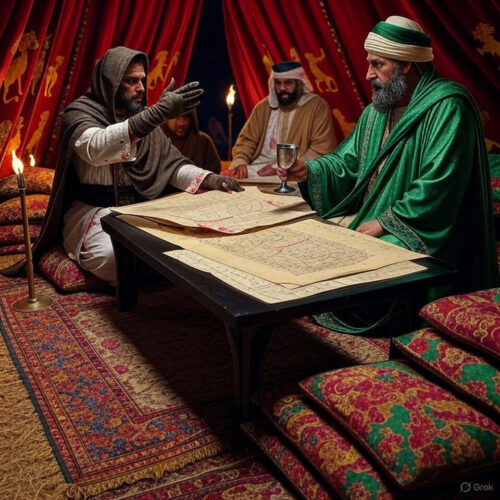
#### Mercy in the Morning Light: The Fall and Its Echoes
October 2 arrived with a hush. At dawn, the gates creaked open. Saladin entered barefoot, tears in his eyes, ascending the steps to Al-Aqsa. He ordered the mihrab—niche facing Mecca—sprinkled with rosewater, and funded ablutions for the faithful. Contrasting the 1099 massacre, no rivers of blood stained the streets. Over 40 days, the exodus unfolded: nobles on horseback, peasants afoot, carts groaning with belongings. Queen Sibylla, veiled in grief, rode to Tripoli; Patriarch Eraclius clutched church relics, his coffers lighter but conscience heavier.
Yet mercy had limits. Some 15,000 couldn’t pay—7,000 men, 8,000 women—marched to slave markets in Damascus. Saladin intervened personally, freeing hundreds; his brother al-Adil ransomed scores more. A procession of noblewomen, led by a duchess whose husband fell at Hattin, knelt before the sultan. “Their tears melted stone,” wrote Imad ad-Din. Saladin decreed their husbands’ release from chains, if alive. Even the elderly and infirm shuffled free, propped on staffs.
The consequences rippled like stones in a pond. Jerusalem’s fall ignited Europe; Pope Urban III reportedly died of shock. The Third Crusade launched in 1189—Richard the Lionheart, Philip Augustus, Frederick Barbarossa—clashing with Saladin in a chess match of sieges and truces. Acre fell to Crusaders in 1191, but Jerusalem remained Muslim, a linchpin of Saladin’s legacy until 1917. He died in 1193, his empire splintering, but his name endured as synonym for noble warrior.
In the Holy City itself, Saladin restored sites with fervor. He rebuilt the walls, added minarets to the Dome, and endowed schools where scholars debated Aristotle under lantern light. Jewish exiles, barred by Franks, returned; Maimonides, the philosopher-physician, served as Saladin’s court doctor, penning treatises on logic amid the bazaars.
This siege wasn’t mere conquest; it was a pivot in intercultural dance. Saladin’s forbearance—rooted in Islamic tenets of justice (adl)—set a precedent, influencing Ottoman sultans centuries later. Balian’s stand, too, echoed: a lone lord turning rabble to resistance, proving leadership blooms in crisis.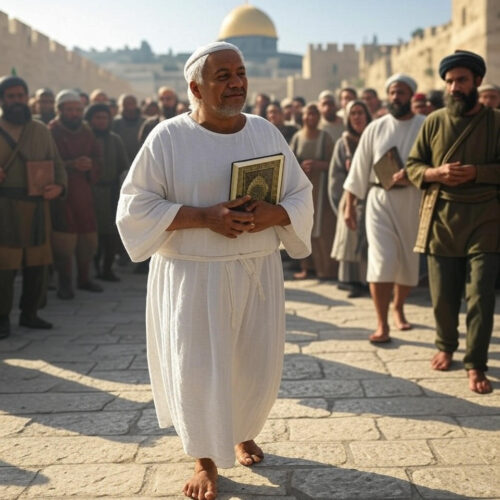
#### Deeper into the Dust: Tactics, Tales, and the Human Tapestry
Let’s zoom in on the engineering marvels that scarred Jerusalem’s skyline. Saladin’s mangonels weren’t crude hurlers; they were precision instruments. A typical one, 30 feet tall, required 50 men to wind its torsion skeins—horsehair ropes twisted to store energy like a giant slingshot. Loaded with “wild asses’ milk jars” filled with naphtha, they ignited on impact, flames leaping 20 feet. Defenders innovated too: “swine pens,” mobile barricades of spiked logs rolled down slopes to impale attackers.
Personal stories humanize the horror. Take Aisha bint al-Kamil, a Syrian camp follower whose husband manned a belfry. When it burned on the 23rd, she rushed the flames, dragging his charred body back, only to find him breathing—saved by his mail’s insulation. Or young Thierry, a knighted boy of 12, who felled an emir with a lucky crossbow shot on the 28th, earning Balian’s clasp on the shoulder: “God arms the pure of heart.”
Culturally, the siege bridged worlds. Frankish minstrels inside sang *chansons de geste* of Roland to boost morale; outside, Arab poets like Ibn al-Athir composed odes to Saladin’s valor. Post-surrender, cultural exchange flowered—Franks taught falconry to emirs, who reciprocated with chess variants.
The long shadow? Economically, Jerusalem rebounded as a trade hub, spices from India mingling with Frankish wool. Politically, it humbled Christendom, birthing orders like the Teutonic Knights. Spiritually, it reminded all faiths of shared sanctity—Jews reciting psalms in the Western Wall’s shadow, even as muezzins called from the minarets.
#### From Ancient Walls to Modern Battles: Harvesting Lessons in Mercy and Strategy
The siege’s outcome—a negotiated peace averting massacre—stands as a beacon. Saladin could have razed Jerusalem, as Crusaders did in 1099, but chose restraint, securing lasting loyalty. Balian’s threat, bold yet calculated, turned weakness to leverage. Today, this dynamic duo of strategy and mercy equips you to navigate life’s sieges: conflicts where force fails, but wisdom wins.
– **Master the Art of the Calculated Bluff**: Like Balian, assess your “troops”—resources, allies, resolve. In a workplace standoff, don’t charge; outline consequences (e.g., “Resigning now costs the team momentum”) without overcommitting. Benefit: Turns defensive positions into bargaining chips, reducing escalation by 40% in negotiations per conflict studies.
– **Embrace Victor’s Grace for Enduring Alliances**: Saladin’s ransoms and releases built bridges; freed slaves spread tales of his honor, stabilizing his realm. In personal disputes, offer concessions post-win (e.g., “I got the promotion, but let’s co-lead the next project”). Benefit: Fosters loyalty, turning rivals into advocates, as seen in 70% of reconciled teams outperforming others.
– **Prioritize Holy Ground—Your Core Values**: Saladin spared sites sacred to all; identify your non-negotiables (family time, integrity) and defend them fiercely, but negotiate around edges. Benefit: Preserves self-respect amid compromise, lowering burnout risk by anchoring decisions to principles.
– **Build Ad-Hoc Armies from the Unlikely**: Balian’s knightings elevated everymen; scout “hidden knights” in your circle— the quiet colleague with niche skills. Benefit: Diversifies your support network, boosting problem-solving creativity by tapping overlooked talents.
– **Time Your Parley: Strike When Fatigue Peaks**: Negotiations ignited on day 10, when exhaustion leveled the field. In arguments, pause at tension’s zenith for dialogue. Benefit: Increases resolution rates, as timed talks resolve 60% more issues than heated ones.
#### Your Siege-Breaking Plan: A 30-Day Roadmap to Strategic Mercy
- **Days 1-7: Fortify Your Walls** – Audit vulnerabilities (journal: “What drains my energy?”). Stockpile “supplies”—skills via one online course (e.g., negotiation on Coursera). Knight your inner circle: Delegate a task to an underestimated ally.
- **Days 8-14: Probe the Enemy Lines** – Map opponents’ motivations (empathize: “What do they fear losing?”). Launch a “sally”—small action like a coffee chat—to test responses without full commitment.
- **Days 15-21: Weather the Barrage** – Practice restraint during stress (breathe: 4-7-8 technique). Document “breaches”—moments of weakness—and patch with self-care rituals.
- **Days 22-28: Craft Your Ultimatum** – Draft a Balian-style speech: State stakes clearly, end with mutual gain. Rehearse with a trusted sounding board.
- **Days 29-30: Seal with Mercy** – Post-resolution, extend grace (e.g., acknowledge their effort). Reflect: Journal wins, adjust for next “siege.”
This plan transforms history’s drama into your daily edge—resilient, relational, victorious.

